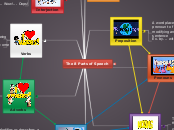da Christine Martin mancano 10 anni
1345
I Ain't Got Nothing But Love For...The 8 Parts of Speech

da Christine Martin mancano 10 anni
1345

Più simili a questo
References
https://www.butte.edu/departments/cas/tipsheets/grammar/parts_of_speech.html
http://grammar.ccc.commnet.edu/grammar/preposition_list.htm
An adjective is a word used to modify or describe a noun or a pronoun. It usually answers the question of which one, what kind, or how many. (Articles [a, an, the] are usually classified as adjectives.)
"The young girl brought me a very long letter from the teacher, and then she quickly disappeared. Oh my!"
Image Accessed on June 9, 2015
http://s2.dmcdn.net/AJQPs/1280x720-aBL.jpg
An adverb describes or modifies a verb, an adjective, or another adverb, but never a noun. It usually answers the questions of when, where, how, why, under what conditions, or to what degree. Adverbs often end in -ly.
"The young girl brought me a very long letter from the teacher, and then she quickly disappeared. Oh my!"
Image Accessed on June 9, 2015
http://images3.cpcache.com/image/38162636_350x350.png
The verb in a sentence expresses action or being. There is a main verb and sometimes one or more helping verbs. ("She can sing." Sing is the main verb; can is the helping verb.) A verb must agree with its subject in number (both are singular or both are plural). Verbs also take different forms to express tense.
"The young girl brought me a very long letter from the teacher, and then she quickly disappeared. Oh my!"
Image Accessed on June 9, 2015
http://images3.cpcache.com/image/38074698_350x350.png
An interjection is a word used to express emotion. It is often followed by an exclamation point.
"The young girl brought me a very long letter from the teacher, and then she quickly disappeared. Oh my!"
A noun is a word for a person, place, thing, or idea. Nouns are often used with an article (the, a, an), but not always. Proper nouns always start with a capital letter; common nouns do not. Nouns can be singular or plural, concrete or abstract. Nouns show possession by adding's. Nouns can function in different roles within a sentence; for example, a noun can be a subject, direct object, indirect object, subject complement, or object of a preposition.
"The young girl brought me a very long letter from the teacher, and then she quickly disappeared. Oh my!"
Image Accessed on June 9, 2015
http://i.ytimg.com/vi/KhOFX9uBww4/hqdefault.jpg
A pronoun is a word used in place of a noun. A pronoun is usually substituted for a specific noun, which is called its antecedent. In the sentence above, the antecedent for the pronoun she is the girl. Pronouns are further defined by type: personal pronouns refer to specific persons or things; possessive pronouns indicate ownership; reflexive pronouns are used to emphasize another noun or pronoun; relative pronouns introduce a subordinate clause; and demonstrative pronouns identify, point to, or refer to nouns.
"The young girl brought me a very long letter from the teacher, and then she quickly disappeared. Oh my!"
Image Accessed on June 9, 2015
https://s-media-cache-ak0.pinimg.com/236x/03/d5/da/03d5da0acaea8a0406c2fce83a026e1d.jpg
A preposition is a word placed before a noun or pronoun to form a phrase modifying another word in the sentence. Therefore a preposition is always part of a prepositional phrase. The prepositional phrase almost always functions as an adjective or as an adverb. The following list includes the most common prepositions:
about, above, across, after, against, around,
at, before, behind, below, beneath, beside,
besides, between, beyond, by, down, during,
except, for, from, in, inside, into, like, near,
of, off, on, out, outside, over, since, through, throughout, till, to, toward, under,
until, up, upon, with, without, according to,
because of, by way of, in addition to, in front of, in place of, in regard to, in spite of, instead of, on account of, out of
"The young girl brought me a very long letter from the teacher, and then she quickly disappeared. Oh my!"
Image Accessed on June 9, 2015
http://i.ytimg.com/vi/byszemY8Pl8/hqdefault.jpg
A conjunction joins words, phrases, or clauses, and indicates the relationship between the elements joined. Coordinating conjunctions connect grammatically equal elements: and, but, or, nor, for, so, yet. Subordinating conjunctions connect clauses that are not equal: because, although, while, since, etc. There are other types of conjunctions as well.
"The young girl brought me a very long letter from the teacher, and then she quickly disappeared. Oh my!"
Image accessed June 9, 2015
http://myemail.constantcontact.com/Save-at-the-Library-.html?soid=1102539683549&aid=D4SEwMBM-kg